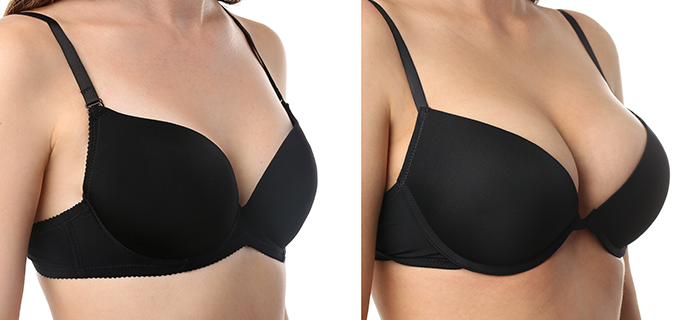Aesthetic breast augmentation, or augmentation mammaplasty, is a surgical procedure to increase the size of the breasts.
A consultation with a plastic surgeon is the first step an individual should take if considering augmentation mammaplasty. You should discuss candidly your expectations regarding the size and contour of your breasts following surgery, while keeping in mind that the desired result is improvement, not perfection.
Emotional stability is one of the most important factors to be established before any aesthetic surgery is undertaken. While augmentation mammaplasty can reshape your breasts, it cannot reshape your life. Aesthetic surgery can improve your appearance and renew your self-confidence, but the rest is up to you.
After examining you,we will discuss other variables that influence the decisions involved in the procedure, such as condition of the breast and skin on the chest wall cavity. For patients with marked sagging of the breasts, we may recommend a procedure to reduce and reshape breast skin in addition to augmentation mammaplasty.
During the initial visit, we will explain specific details of your case, including the surgical technique to be used, the anesthesia, where the operation will be performed and what the surgery realistically can accomplish. Additional factors to consider before electing augmentation mammaplasty, such as risk and cost, should be discussed with the surgeon at this time.
Thousands of augmentation mammaplasties are performed successfully each year. Nevertheless, you should be aware of the potential risks of surgery and complications associated with augmentation mammaplasty. Postoperative complications such as infection or localized collections of blood are uncommon and can be treated. Occasionally a second operation may be required to soften breasts that become too firm due to excessive scar formation called capsular contracture. Risk of complications can be minimized by closely following your surgeon’s advice on follow-up care during the healing process.
The Surgical Procedure
Augmentation mammaplasty typically is performed to enlarge small, underdeveloped breasts or breasts that have decreased in size, or atrophied, after childbearing. It may also be done to balance assymetry that may result from post mastectomy reconstruction. (Fig. 1) The extent of the procedure depends on what changes are desired and what your surgeon deems appropriate.
Augmentation mammaplasty usually is performed under a general anesthetia, although a local anesthetic which numbs the area around the breasts may be used. Medication to relieve tension is given before the anesthetic is administered. The sedative and local anesthetic allow you to be comfortable during surgery. If a general anesthetic has been adminstered, you will sleep through the entire operation.
There are several possible surgical approaches to breast augmentation. The most commonly employed techniques are an inframammary incision which is made slightly above where the lower part of the breast touches the chest, or a periareolar incision which is made around the lower border of the areola, the dark pink skin that surrounds the nipple. Another less frequently used approach is an axilla incision made in the armpit. (Fig. 2) The surgical technique employed will depend on the surgeon’s preference.
Working through the incision, the surgeon lifts breast tissue up and skin down to create a pocket either directly under the tissue or underneath the chest wall muscle, depending on the surgeon’s technique and the patient’s anatomy. (Fig. 3) In the pocket the surgeon places a breast implant, or prosthesis, which is a flexible plastic envelope containing a silicone gel, (Fig. 4) A few sutures close the incisions. Following surgery, the patient is placed in a surgical bra. Depending on the extent of the surgery, the procedure usually lasts about two hours or longer.
After surgery, pain that is easily controlled by medication usually will subside in a day or two. The patient is discharged a few hours after the operation. Sutures will be removed within a week of surgery. Although we have made every effort to keep scars as inconspicuous as possible, they are the inevitable result of surgery. In most cases, they will begin to fade gradually and become barely noticeable. Minimal swelling and discoloration of the breasts will disappear rapidly. The objective of augmentation mammaplasty is breasts that look fuller and more natural in appearance.
Asymmetry of the breasts may result from a difference in the healing process on the two sides. Some degree of firmness of the breasts may occur for weeks or even months following surgery. In some instances, we may recommend a program of breast massage to promote softness. There may be a loss of sensitivity in the nipples following the operation, but in most cases a degree of sensitivity will return.To permit proper healing, the patient should avoid overactivity and refrain from overhead lifting. The decision on when to return to work and normal activities depends on how fast the patient heals and how she feels. In general the patients can return the daily activities within a week
